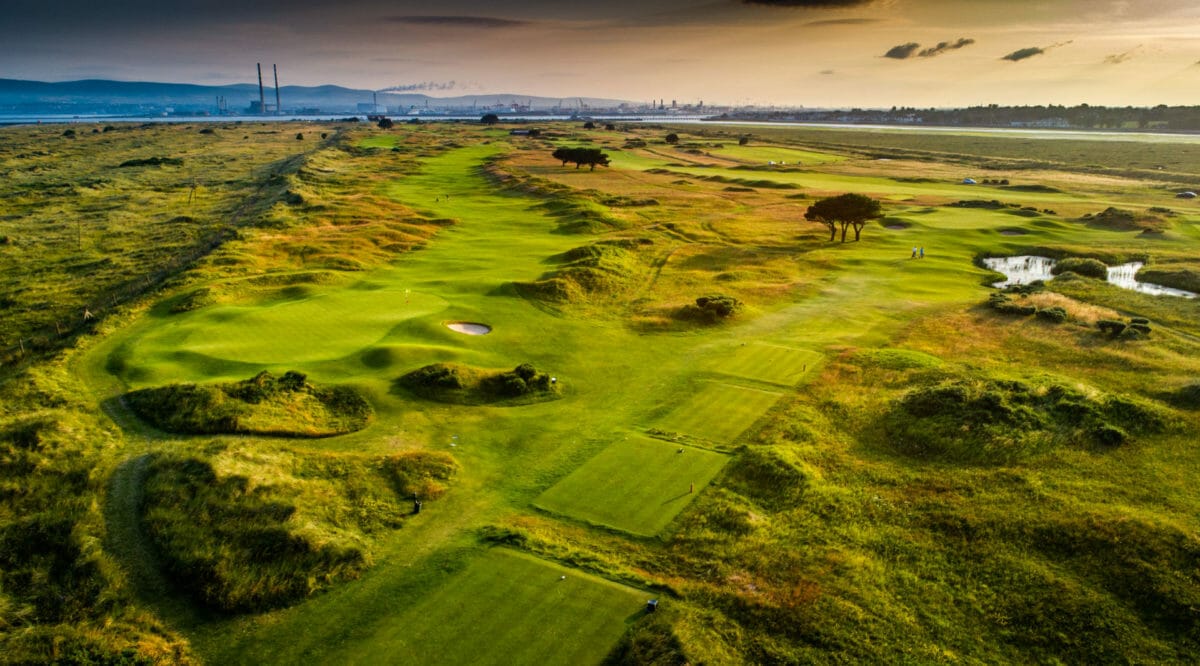Have you been to Bull Island? Do you know its history? One bird sanctuary, two links golf courses, three miles from Dublin city centre and a five kilometre beach (Dollymount Strand) that stretches from one end of the island to the other.
Maybe it’s not that relevant to this Royal Dublin article but it is an interesting history nonetheless… and the side panel overleaf offers one of Dublin Port’s more remarkable evolutions.
Still, it is an interesting quirk of history that Ireland’s newest island is home to Ireland’s oldest links course so close to the capital’s centre. That makes it the perfect location for a corporate day out… as well as late summer rounds after work, which is when I last played it.
My friend and I played here on a beautiful sunny June afternoon. We found a lovely tempo that swept us around this low links until we reached the 17th, where we caught the fourball in front. And it was here that we encountered two members, Louis and Connor. We watched from the 17th tee as Louis drove the famous par four 16th (282 yards) by bouncing his way over the crisp turf and between the seven pincer-like bunkers. We waited for them on the tee and then agreed to play a two-hole match over the final holes. At stake was a pint. We won 17 with a par; they won the intimidating 18th with the same. Honours even… and they bought the pints as we sat on the clubhouse balcony overlooking the unmistakeable final hole. Our hosts were happy to discuss the club history and it was clear that members are keen to promote the Royal Dublin story.
In 1885, the Dublin Golf Club was instituted. Play started in Phoenix Park before golf moved to Bull Island, in 1889. Two years after that the club received its Royal designation. What is particularly interesting is that in just 43 years the island had grown to such an extent that golf could be played on its terrain.
In 1920, Harry Colt arrived to design a traditional links… and what he created has been receiving plaudits ever since. That sense of tradition is ably assisted by the striking red and white clubhouse which lies at the southern tip of the island. It was opened by the Taoiseach, John Costello, in 1953.
It is difficult, given such a long and rich history, to highlight just two luminaries of the club. There are those who founded it (particularly the Scot, John Lumsden), those who designed it (Harry Colt, with revisions by Martin Hawtree in the 1990s) and the legends who called it home… namely Michael (Dyke) Moran and Christy O’Connor Senior. Identifying these two golfing greats is made easier by plaques dedicated to them on the golf course. The first appears on the gentle dogleg 3rd, which uses an old cottage as part of the fairway. You have to wonder how many times it has deflected balls towards the green. The plaque is on one wall. Michael “Dyke” Moran was born in this small one-roomed cottage in 1886, before the golf course existed. Twenty three years later, in 1909, as Royal Dublin’s playing professional he won the first of his Irish Professional Championships. He went on to win it for the next four years, a feat which has never been equalled. During those years he also tied for third place with Harry Vardon, in the 1913 Open Championship at Royal Liverpool. He died in 1918, at just 32 years of age, fighting with the Royal Irish Regiment in France.
The second legend is none other than ‘Himself’. Christy O’Connor Senior joined Royal Dublin in 1959 as the club professional. His association with the club continued for 57 years and while he won many tournaments and competed in 10 Ryder Cups, his greatest legacy must be the manner of his 1966 Carrolls International victory, here on Bull Island. On the 16th tee a plaque stops visitors in their tracks. I, for one, have read it on every visit. How many golfers can you think of who have won a tournament by finishing the last three holes eagle (2), birdie (3), eagle (3)? Is it any wonder he is so revered, not just by this club but by Ireland, too. People still talk about it to this day.
The 18th hole has not been a par five in many years and today it is a brutal par four measuring 460 yards. It is a right angle dogleg with out of bounds along the right, within the elbow of the dogleg. Two very good blows are required to reach the green – Himself did it with two four irons by cutting the corner but not many of us can achieve that.
Which leads to the matter of how you play this course. There are some seriously hefty par fours here, with five over 430 yards (white tees), but the 130 bunkers may cause the greatest fear. Their positioning is exceptional and that means every tee shot and every approach has to be evaluated with the sand in mind. What’s more, as one of Ireland’s flattest links you need to look at each hole carefully, appreciate the subtleties of the fairway shapes and then factor in the wind. Gentle doglegs abound, starting as early as the par five 2nd, and sometimes just the positioning of the tee box means club selection and line are a mass of possibilities.
Royal Dublin is famous for its classic out-and-back routing with the front nine heading north-east. These are regarded as the easier nine for the wind will typically be at your back (although not on the three par threes). But then you must turn for home and that changes everything. Even Rory McIlroy found that his fine score on the front nine was hard to maintain on the homeward trail. This can best be summed up by the Index 1 10th hole, which is at the farthest reaches of the links. Here the wind will typically be into your face. At 441 yards (white tees) it is another subtly shaped hole that drifts around two fairway bunkers on the right, before you must tackle a narrow dyke short of a bunkerless green. No bump and run means the adventurous golfer has to fly it the whole way, into that wind. I will add that on the day we played the wind was behind us… which made it only marginally easier: the challenge then was how to stop the ball on the green without falling victim to the endless fall-offs that sweep around most of Royal Dublin’s greens. And after the two bunkers on the 10th, you will face 13 on the par five 11th.
A strategic mind is required here. As McIlroy discovered, what the wind giveth, it taketh away. It is safe to say that this is a challenging ‘second shot’ course because the greens are so slick, their shapes elusive and the slopes around the sides treacherous. Bunkers are deep and with so many of them you will need to be extremely lucky or skilled to avoid them for 18 holes. Fairways are rarely generous – not helped by the constant subtle doglegs – and water, appearing as smartly presented dykes, influences play on several holes (10 and 14 in particular, where a dyke crosses the fairway).
The large greens are things of beauty and there is something about the small stands of pine trees scattered around the course that makes the greens stand out all the more. They rarely influence play but they act as dark and brooding anchors that help establish where you are on the links.
The clubhouse is laced with history, including rooms dedicated to Moran and O’Connor, and a tour of the clubhouse should be compulsory. The photographs, trophies, books – and the clubhouse itself –are essential for anyone who wants to get a true sense of what this club is about, as well as appreciating Irish golf’s history. Golfers on corporate days will lap it up… but you don’t even have to be playing here as the club also rents out function and meeting rooms to interested parties. But for those companies looking to treat clients or staff to a day out, the club tailors the day around you – from shotgun starts and beat-the-pro to complementary range balls and trollies.
Jeff Fallon, the club’s youthful General Manager, looks after Royal Dublin’s corporate clients.
“The Club is always trying to improve the customer experience,” he says, “be it for a visitor or a member. Our members are very proud of what the club has to offer and they are our best ambassadors when it comes to adding to the visitor experience. We encourage them to interact with visitors to give them a more authentic experience compared to what you might receive at a commercial club. From a customer service perspective we ensure our front of house staff from the Pro Shop to the starter, through to our clubhouse staff give the visitor a warm Royal Dublin welcome and provide an attentive and first class level of service.”
Royal Dublin has for a long time borne the mantle of one of Ireland’s most formal clubs… but as Fallon indicates such things have been shrugged off and the club is now far more relaxed. Only the Christy O’Connor Room requires guests to wear a jacket. Visitors are welcome and welcomed.
Your final act of the day should be to go and see Christy O’Connor Senior’s Ryder Cup in the trophy room. He should have been given ten, one for each of his appearances, but this is the only one he received and his family presented it to Royal Dublin to acknowledge the abiding relationship between Himself and Ireland’s oldest links.
A History
A history lesson on Bull Island is required for you to appreciate how this golf course came about – both in its origins and its shape. It is a fascinating story that dates back to 1800 and the unmistakeable name of Captain William ‘Mutiny on the Bounty’ Bligh. He was asked by the Director General of Inland Navigation to conduct a sounding of Dublin Bay. At issue were the levels of sand being carried by the tides which were obstructing large ships from entering the port. After he had completed his work, Bligh recommended that a wall (the North Bull Wall) should be constructed, parallel to the South Bull Wall, as this would prevent sand building up in the mouth of the harbour.
His advice was heeded closely and when the North Bull Wall was fully completed in 1842, sand did indeed start to accumulate along its side. This extended quickly until Bull Island emerged. The island today is roughly five kilometres long and 800 metres wide. It became home to the first official Bird Sanctuary in Ireland, in 1931. In 1981 it was further recognised as a UNESCO Biosphere Reserve due to its threatened habitats and species, not to mention its importance to overwintering birds.
Royal Dublin is one of Ireland’s few clubs to boast an island location. You don’t get a ferry across (as at Waterford Castle) but the wooden causeway to the island was only built in 1962, due to the growth of car ownership.
St. Anne’s Golf Club was first developed alongside Royal Dublin in 1921.























Leave a comment